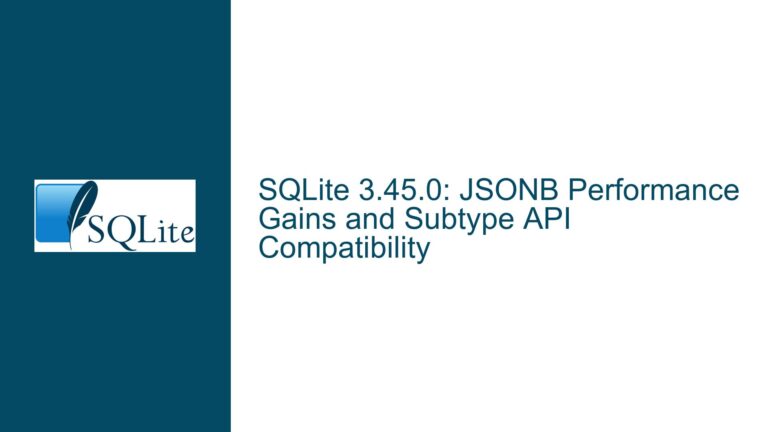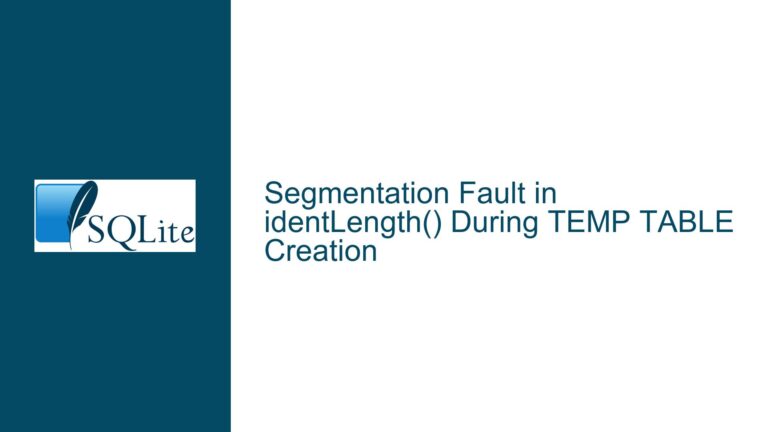Memory Leaks in SQLite Application with Multi-threaded Access
Issue Overview: Memory Leaks Detected by MSVC Runtime but Not by VLD
The core issue revolves around memory leaks detected by the Microsoft Visual Studio (MSVC) runtime in an application that uses SQLite. The application is built using MSVC 2017 and employs Visual Leak Detector (VLD) to identify memory leaks. However, VLD reports no memory leaks, while the MSVC runtime detects several leaks, particularly in the form of normal blocks of memory that are not freed before the program exits. The memory leaks are associated with cursor-related operations, as indicated by the repeated patterns in the memory dump, such as the string "c u r s o r – f" and blocks of 124 bytes.
The application accesses the SQLite database from two different threads: the main thread, which handles the primary database queries, and a secondary thread, which continuously checks for schema changes and updates internal structures accordingly. The application uses appropriate locking mechanisms to ensure data consistency. However, the multi-threaded nature of the application raises questions about whether the memory leaks are related to concurrent access to the SQLite database.
Possible Causes: Multi-threaded Access, Error Handling, and Compiler Flags
The memory leaks could be attributed to several factors, including improper handling of SQLite resources in a multi-threaded environment, incomplete error handling, or incorrect compiler settings.
Multi-threaded Access: SQLite is designed to be thread-safe, but using a single database connection across multiple threads without proper synchronization can lead to unpredictable behavior, including memory leaks. The application uses a single connection from both the main and secondary threads, which could result in concurrent access issues. Although the application employs locking mechanisms, it is possible that these mechanisms are not fully effective in preventing resource contention, leading to memory leaks.
Error Handling: Another potential cause is incomplete error handling in the application. SQLite functions, such as sqlite3_exec, allocate memory for certain operations, and this memory must be explicitly freed in case of errors. If the application fails to release this memory, it could result in memory leaks. The user mentioned that every call to the SQLite API is checked for errors, but it is possible that some error paths do not properly free allocated resources.
Compiler Flags: The choice of compiler flags can also impact memory management. The MSVC runtime has both multi-threaded and single-threaded variants. Using the single-threaded runtime in a multi-threaded application can lead to memory management issues, including leaks. The user acknowledged that they need to check their compiler options to ensure that the correct runtime library is being used.
Troubleshooting Steps, Solutions & Fixes: Addressing Memory Leaks in SQLite Applications
To resolve the memory leaks, the following steps should be taken:
1. Verify Multi-threaded Access Patterns:
- Dedicated Connections: Ensure that each thread has its own dedicated SQLite connection. Sharing a single connection across multiple threads, even with locking mechanisms, can lead to resource contention and memory leaks. By creating separate connections for each thread, you can avoid these issues.
- Thread-safe Mode: Confirm that SQLite is compiled in thread-safe mode. This can be verified by checking the
SQLITE_THREADSAFEcompile-time option. If SQLite is not in thread-safe mode, concurrent access from multiple threads can lead to undefined behavior, including memory leaks. - Synchronization Mechanisms: Review the locking mechanisms used in the application. Ensure that they are correctly implemented and effectively prevent concurrent access to shared resources. Consider using higher-level synchronization primitives, such as mutexes or semaphores, to manage access to the database connection.
2. Review Error Handling and Resource Management:
- Memory Allocation and Deallocation: Carefully inspect all SQLite API calls, particularly those that allocate memory, such as
sqlite3_exec. Ensure that memory is properly freed in all error paths. For example, ifsqlite3_execreturns an error, any memory allocated for the result set must be freed usingsqlite3_free. - Error Logging: Implement comprehensive error logging to capture any unexpected errors or exceptions that occur during database operations. This can help identify code paths where resources are not being properly released. Logging should include details such as the error code, the SQL statement being executed, and the call stack at the time of the error.
- Resource Cleanup: Ensure that all SQLite resources, such as prepared statements (
sqlite3_stmt), are properly finalized and freed when they are no longer needed. Usesqlite3_finalizeto release prepared statements andsqlite3_closeto close database connections.
3. Validate Compiler and Runtime Settings:
- Compiler Flags: Check the compiler settings to ensure that the multi-threaded runtime library is being used. In MSVC, this typically involves setting the
/MTor/MTdflag for the release and debug builds, respectively. Using the single-threaded runtime (/MLor/MLd) in a multi-threaded application can lead to memory management issues. - Runtime Checks: Enable runtime checks for memory leaks in MSVC. This can be done by setting the
_CRTDBG_MAP_ALLOCflag and including the<crtdbg.h>header file. This will enable detailed memory leak reporting, including the file and line number where the leaked memory was allocated. - VLD Configuration: Re-examine the configuration of Visual Leak Detector (VLD). Ensure that VLD is correctly initialized and that it is monitoring memory allocations throughout the entire lifetime of the application. If VLD is not detecting leaks, it may be due to incorrect initialization or monitoring intervals.
4. Debugging and Profiling:
- Call Stack Analysis: Use the call stack information provided by VLD to trace the origin of the memory leaks. The call stack should indicate where the leaked memory was allocated, allowing you to identify the specific code paths that are not releasing resources.
- Memory Profiling: Consider using a memory profiling tool, such as Valgrind (on Linux) or Dr. Memory (on Windows), to gain deeper insights into memory allocation and deallocation patterns. These tools can help identify memory leaks that are not detected by VLD or the MSVC runtime.
- Stress Testing: Perform stress testing on the application to simulate high-concurrency scenarios. This can help uncover memory leaks that only occur under specific conditions, such as when multiple threads are accessing the database simultaneously.
5. Code Review and Refactoring:
- Code Review: Conduct a thorough code review to identify potential sources of memory leaks. Pay particular attention to areas where SQLite resources are allocated and freed, as well as any custom memory management code.
- Refactoring: Refactor the code to improve resource management and error handling. Consider using RAII (Resource Acquisition Is Initialization) principles to ensure that resources are automatically released when they go out of scope. For example, use smart pointers or custom wrapper classes to manage SQLite resources.
By following these steps, you can systematically identify and resolve the memory leaks in your SQLite application. The key is to carefully manage resources in a multi-threaded environment, ensure comprehensive error handling, and validate compiler and runtime settings. With these measures in place, you can achieve a robust and leak-free application.






